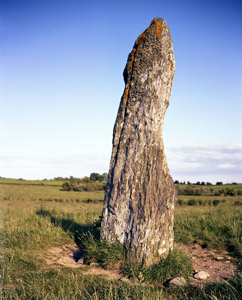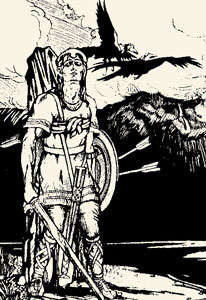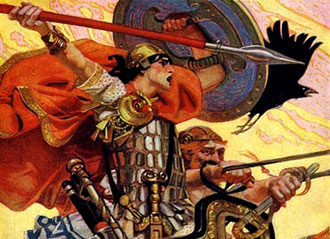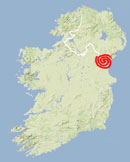25 Aug Clochafarmore
“Cúchulainn and his friends are historical characters, seen as it were through mists of love and wonder, whom men could not forget, but for centuries continued to celebrate in countless songs and stories. They were not literary phantoms, but actual existences; imaginary and fictitious characters, mere creatures of idle fancy, do not live and flourish so in the world’s memory.”
Standish O’Grady, The Coming of Cuculain, 1894 1
“There are three deaths. The first is when the body ceases to function. The second is when the body is consigned to the grave. The third is that moment, sometime in the future, when your name is spoken for the last time.”
David Eagleman, “Metamorphosis,” Sum: Forty Tales from the Afterlives, 2009 2
Drag within the image to view the Clochafarmore Stone in virtual reality.
“One knows one will be long forgetting Cúchulainn, whose life is vehement and full of pleasure, as though he always remembered that it was to be soon over.” 4
The ancient monuments considered in these pages were likely inspired by extraordinary individuals. They must have led lives of considerable importance for them to be memorialized by these imposing megalithic structures. Is it not likely that their names were still spoken many years after their deaths?
Now, a few thousand years afterwards, there are still tales told about these monuments, and the warriors, witches, or giants whose deeds they commemorate or whose remains they shelter. These stories create, at least in the abstract, a continuation of the folk memory of the person buried in the tomb. These “voices from the dawn” are, within David Eagleman’s construct, the words that postpone that awful final death, when the name of the deceased is never again uttered.
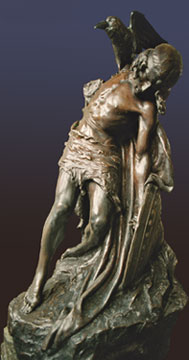
The Dying Cuchulain (1911) by Oliver Sheppard, at the GPO, Dublin. Click to enlarge and rotate.
View full screen.
The tragic end of Cúchulainn, the half-human, half-supernatural hero of the armies of Ulster in the Táin Bó Cúailnge3 is a case in point. This 3 m (10 ft) tall standing stone is known as Clochafarmore, or the Big Man’s Stone. According to legend, the mortally wounded Cúchulainn bound himself to this pillar, standing tall to keep his enemies at bay until the moment of his death.
The story of the death of Cúchulainn has provided a metaphor for the resolve of the Irish nation. A 1911 sculpture of the hero (right), bound to his standing stone, occupies a prominent spot at the General Post Office in Dublin, a hallowed scene of battle during the ill-fated Easter Rising of 1916.
Paradoxically, the same champion provides heroic imagery for those who were the fiercest opponents of the fight for Irish independence in 1916. Wall murals painted in the Unionist enclaves of Belfast (see photo in gallery) evoked Cúchulainn, the Hound of Ulster,5 in their resolve to remain forever British.
Cúchulainn was born of a noble mother, Deichtine, the sister of the king who ruled Ulster from its capital at Emain Macha (Navan Fort). Cúchulainn‘s father, however, was the god Lugh, who entertained Deichtine at his home in Newgrange, the great mound at Brú na Bóinne (the Palace of the Boyne),6 and who was said to have been killed during a battle at the Hill of Uisneach.
While still a child, Cúchulainn overheard the Chief Druid explaining to his pupils that whoever took up arms that particular day would be famous in Ireland forever. Cúchulainn immediately ran off to enlist as a warrior. He did not stay to hear the rest of the druid’s explanation—that while his name would live forever, his life would be short. When he discovered this, Cúchulainn replied, “Provided that I shall be famous I do not care if I last in this world for only a single day.”7
“When Cúchulainn was growing out of his boyhood at Emain Macha, all the women of Ulster loved him for his skill in feats, for the lightness of his leap, for the weight of his wisdom, for the sweetness of his speech, for the beauty of his face, for the loveliness of his looks, for all his gifts. He had the gift of caution in fighting, until such time as his anger would come on him, and the hero light would shine about his head; the gift of feats, the gift of chess-playing, the gift of draught-playing, the gift of counting, the gift of divining, the gift of right judgment, the gift of beauty.” 8
In the Iron Age culture in which these stories are placed, around the first century CE, battle weapons included the sling, in which Cúchulainn had acquired great skill. But his most extraordinary weapon was his horrible spear, called the Gáe Bulga, which its victim could not extract from the wound. Thus it was always fatal.9 The Gáe Bulga would ultimately prove to be the hero’s undoing.
At the age of seven Cúchulainn was returning home from a great battle, in which he had taken many heads. Unfortunately, he was still possessed by his “battle-rage,” in which he could not control his super-human martial powers, and could not distinguish friend from foe. The men of Ulster {the “Ulaid”) devised a plan to bring him back to normalcy. First, they sent out 130 bare-breasted women, causing him to avert his eyes in modesty. Then they grabbed him and plunged him into a vat of cold water, which immediately exploded. They plunged him into a second vat, which quickly boiled over. Finally, when they put him into a third vat, it merely became hotter than the average person could bear. “But the ‘fury’ had then left him.”10
Cúchulainn’s “battle-rage” (also “warp-spasm,” or “berserker’s frenzy”) was the signature behavior that would today provide him marquee status as a superhero. Like some Incredible Hulk of the Iron Age, he would become a fearsome shape-shifter when his “…anger came on him, and the flames of the hero light began to shine about his head…and he lost the appearance of a man, and what was on him was the appearance of a god.”11
In The Táin, his 1969 translation of the traditional tales, Thomas Kinsella conveys the power of this horrible transformation:
“The first warp-spasm seized Cúchulainn, and made him into a monstrous thing, hideous and shapeless, unheard of. His shanks and his joints, every knuckle and angle and organ from head to foot, shook like a tree in the flood or a reed in the stream. His body made a furious twist inside his skin, so that his feet and shins and knees switched to the rear and his heels and calves switched to the front…His face and features became a red bowl : he sucked one eye so deep into his head that a wild crane could not probe it onto his cheek out of the depths of his skull; the other eye fell out along his cheek…His heart boomed loud in his breast like the baying of a watch-dog at its feed or the sound of a lion among bears.” 12
When Cúchulainn finally came to his end, it was not due to any diminishing of his ferocious skills of battle. Rather it was a combination of trickery and magic that led him to his final hour, bleeding and bound to the Clochafarmore Stone in this field near what would become the town of Knockbridge in Co. Louth.
His life-long enemies gathered to conspire against him. Chief among them was Lugaid, whose father, Cú Roí, was killed by Cúchulainn at his mountaintop fortress of Caherconree. There were other men as well, men made fatherless by the warrior prowess of Cúchulainn.
In the formulaic chivalry of these tales, fighters were bound by certain geasa, or taboos. For Cúchulainn, there were two geasa that created for him a quandary he could not avoid. He could never refuse any hospitality that was offered him, and he could never eat the meat of a dog. Thus, when he encountered three one-eyed hags who invited him to join them at their feast of roast dog, he was forced to break one or the other of his geasa. After his first bite of the dog meat the strength drained out of one side of his body.
When the battle began, it first seemed that Cúchulainn would again prevail, as he always had before:
“…Cúchulainn came against them in his chariot, doing his three thunder feats, and he used his spear and his sword in such a way, that their heads, and their hands, and their feet, and their bones, were scattered through the plain of Muirthemne, like the sands on the shore, like the stars in the sky, like the dew in May, like snow-flakes and hailstones, like leaves of the trees, like buttercups in a meadow, like grass under the feet of cattle on a fine summer day.” 13
He then encountered a Druid, in league with Lugaid, who asked Cúchulainn for his enchanted spear. When the hero initially refused, the Druid threatened to compose a poem that would satirize him for his lack of generosity. At this, Cúchulainn relented, and killed him with his spear. This, however, allowed Lugaid to obtain the weapon, and with it put an end to Láeg, Cúchulainn s faithful chariot driver.
Afterwards, another Druid deployed the same ruse, giving his life so that Lugaid could again get his hands on the Gáe Bulga, and with it kill the Grey of Macha, Cúchulainn’s “king of horses.” Then, the last of Lugaid’s Druids, again using his trickery, goaded the hero into skewering him with the magical spear.
“‘You do your kindness unkindly, Cúchulainn,’ said the Druid, as he fell. Then Cúchulainn drove for the last time through the host, and Lugaid took the spear, and he said: ‘Who will fall by this spear, children of Calatin?’ ‘A king will fall by it,’ said they…
Then Lugaid threw the spear, and it went through and through Cúchulainn’s body, and he knew he had got his deadly wound; and his bowels came out on the cushions of the chariot, and his only horse went away…and left his master, the king of the heroes of Ireland, to die upon the plain of Muirthemne.” 14
Cúchulainn, mortally wounded, received Lugaid‘s permission to quench his thirst in the nearby lake, promising to return. He then saw near the lake a tall pillar stone, marking the grave of a warrior slain there in some ancient battle. He staggered to the stone, and removed his girdle and used its cords to bind himself to the pillar. With his dying breath he gave a great sigh, forming the crack in the stone that may be seen today.15 From a distance, his enemies were watching him.
“So afar they retreated, when they beheld him standing with the drawn sword in his hand, and the rays of the setting sun bright on his panic-striking helmet. So stood Cúchulainn, even in death pangs a terror to his enemies and the bulwark of his nation.” 16
It was three days later when the Morrígan, Celtic goddess of war and fertility, appeared as a raven and landed on his shoulder. Only then did his enemies believe that he was dead, and dared to approach him. But as Lugaid went over to the Clochafarmore Stone to cut off the head of his vanquished enemy, the “hero-light” burned around Cúchulainn one last time, and his sword fell from his grip. As it fell, it severed the hand of Lugaid. And only then was Cúchulainn’s hero-light finally extinguished. With his one remaining hand Lugaid was able to take the head of Cúchulainn.
Lugaid may have intended to take his prize away with him as a gift for Queen Maeve at Rathcroghan. But Cúchulainn’s death was quickly avenged by his brother-in-arms, Conall Cernach, who killed Lugaid and took the head and the right hand of Cúchulain and buried them at the Hill of Tara, “with his shield’s fill of earth being used to cover them.” Cúchulainn, the Hero of Ulster, died in his 27th year.17
The various stories of Cúchulainn and the other tales of the Ulster Cycle come from manuscripts dating from the twelfth century or earlier. It is believed that the stories themselves were almost always known from older sources. For example, the story of Cúchulainn’s birth is from Lebor na hUidre (The Book of the Dun Cow, c. 1106), where it is claimed that the story originated in a lost text, The Book of Druim Snechta, said to date from the eighth or ninth century.18
The Ulster Cycle historically was the literature of the aristocracy and the clergy. By the eighteenth and early nineteenth centuries, when Cúchulainn appears at all in popular folktales it is as a caricature of the hero of the original stories, perhaps even as a stupid or pompous giant. But by the time of the Gaelic Revival in the mid-nineteenth and early twentieth centuries, the Cúchulainn of the Iron Age was re-emerging. The original spirit of the stories of the Ulster Cycle were being presented to a new audience, with translations and re-workings of the material by Lady Gregory, W.B. Yeats, Standish O’Grady and, more recently Thomas Kinsella and Ciaran Carson. Some of these are excerpted here.19
Nearby the Clochafarmore Stone in the 1920s someone found an ancient bronze spearhead.20 Could this have been evidence of the long-ago battle? Unfortunately the spearhead was given to the parish priest for safekeeping rather than to a museum. It was subsequently lost. Is it possible that the legendary hero tales of Cúchulainn were based, at least in part, on folk-memories of the exploits of one or more flesh-and-blood Iron Age warriors? It is not easy to say. It may be just as likely that his character was invented in the early years of the Christian era so as to provide Ireland with a mythological analog for the classical Achilles.
While the personages may not have been real, there is no argument about the certainty of the places. The Clochafarmore Stone, in its hard-edged reality, most likely was erected as a memorial of some sort. Its naming, however, was a part of the “topographic preoccupation,” to use Kinsella’s phrase, that was characteristic of early and medieval Irish writing.21 The Dindsenchas manuscripts of early Irish literature are the explanations of place names. In modern Irish, the word dinnseanchas means “topography.”
In the fourth century CE, St. Helena traveled throughout the Holy Land designating particular locations to be forever identified with the stories of the Bible. Was there a similar process underway in Ireland during the early Medieval period, with the authors of the place-name stories traveling about the countryside seeking ancient stones and tombs that might provide a grounded verisimilitude for the appropriate legendary personage?
The region of Rathiddy Townland where the Clochafarmore Stone sits was referred to in the Ulster Cycle as An Breisleach Mor, “The Great Carnage.” The gently rolling area of the pillar stone is still known locally as the “Field of Slaughter.”22
So how has Cúchulainn fared, using David Eagleman’s allocation of “three deaths” for each person? Has he managed to stave off his ultimate demise, when his “name is spoken for the last time”? Judging by Ciaran Carson’s new translation, the graphic novel, and the other diffusions of the Ulster hero into the realm of popular culture,23 the answer would seem to be in the affirmative. In many different ways, traditional and modern, the name of Cúchulainn continues to be heard.
“Those who listened to [the stories of Cúchulainn] must have felt as if the living were like rabbits digging their burrows under walls that had been built by Gods and Giants, or like swallows building their nests in the stone mouths of immense images, carved by nobody knows who…The fruit of all those stories…is the quick intelligence, the abundant imagination, the courtly manners of the Irish country people.”
W.B. Yeats, 190324
Click here to see all the notes from this page.
Clochafarmore Standing Stone, Co. Louth
Nearest Town: Knockbridge
Townland: Rathiddy
Latitude: 53° 58′ 28.25″ N
Longitude: 6° 27′ 57.18 W
external links:
Some of the Cúchulainn texts may be read in their entirety online:
Cuchulain of Muirthemne
The Triumph and Passing of Cuculain
Cuchulain, the Hound of Ulster

